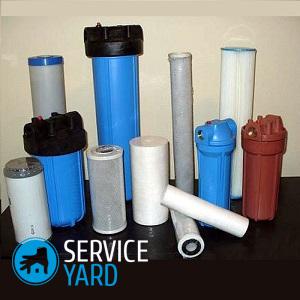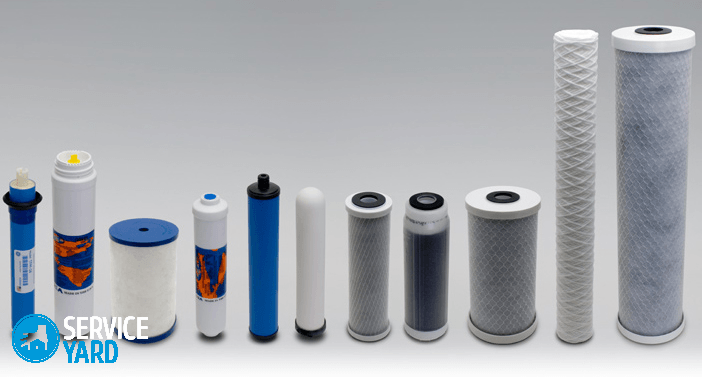Cartridges for water purification

- Types of cartridges for water treatment
- Osmotic cartridge for water purification
- Membrane cartridge for water treatment
- Ion exchange cartridge for water treatment
- Adsorption cartridge
- Principle of operation
- Water cartridge life
- Installation sequence
- Rules for choosing a replacement cartridge for water treatment:
- Stock footage
Tap water is not suitable for drinking and cooking, so more and more often owners of private houses and apartments install household filters. In this article we will look at what replaceable cartridges are for cleaning water and which one to choose so that tap water becomes suitable for drinking.
to contents ↑Types of cartridges for water treatment
There are jug type filters that can satisfy the family's need for drinking water only, and filters installed on the water supply system of an apartment or house. The latter type of cleaning device fully provides the house with high-quality water, which can be used both for drinking and for cooking.
What are cartridges for water treatment? - There are 4 main types:
- Osmotic;
- Membrane
- Ion exchange;
- Adsorption;
Let us consider in more detail what constitutes each of the types, as well as the principle of their action.
to contents ↑Osmotic cartridge for water purification
Today the osmotic type of filter is the most effective for water purification. Install it with a pump and an additional storage tank under the sink. Over the entire life of such a filter can clean up to 15 thousand liters of water.
Important! Bottled water, which is sold in stores, undergoes this particular type of treatment.
The principle of operation of the osmotic cartridge
In such replaceable filters there is a cylindrical shaped cloth partition, which divides the water into 2 streams. The principle of operation of the cartridge is based on the forced dragging of water through this membrane. The pressure that brings the system into equilibrium is called osmotic. Thus, under the influence of such pressure, water, which contains suspended particles and impurities, begins to penetrate through the fabric or polymer membrane.
Important! All contaminants accumulate on the membrane. The design has cells of microscopic dimensions, through which only molecules of water, oxygen and other gases can penetrate.
The purification process - stages:
- Mechanical cleaning.
- Removal of dissolved gases and chlorine.
- Purification from organic compounds. For this, compressed activated carbon is used.
- Eliminate harmful metals such as lead and mercury with a special membrane with a cell diameter of 0.004 microns.
- Water purification with carbon post-filter, after which the water is suitable for drinking and cooking.
The advantages of this filter:
- Provides a constant flow of water at a pressure of 3.5 atmospheres in 2 liters.
- High degree of purification.
- The compact size allows you to place the filter under the sink without any problems.
Disadvantages:
- The need to complete the system with a storage tank and in case of low pressure in the main line with a pump.
- The high cost of the cartridge.
- Relatively low performance.
Membrane cartridge for water treatment
This filter is a molecular sieve from the cells in the membrane. The diameter of the cells is equal to the diameter of the water molecule. Thus, only water passes through the membrane, leaving all impurities on the surface. For service life cleans up to 15 thousand liters.
Important! Membranes do not pass all organic and insoluble solids.
Principle of operation
Membrane cartridges for water purification come in several forms:
- Mechanical cleaning. The mechanical water treatment cartridge allows to retain large grains of sand, rust and other large particles due to different pore sizes in the microfilter. Using an ultrafilter, bacteria are removed.
- Sorption. The filter element consists of activated carbon, which can remove organic impurities, phenolic and chlorine compounds, eliminate odors, organic substances and bring the color of the liquid back to normal.
- Electrochemical cleaning. Water flows through several chambers, where the redox reaction takes place under the influence of an electric field. This process contributes to the complete destruction of microorganisms, the destruction of toxic products, the removal of compounds of heavy metals.
- Membrane reverse osmosis. The operation of the system is based on the principle of thin-film membranes.
Benefits:
- Long term of operation.
- High degree of water purification (delay of almost 100% insoluble solids, organic and chemical inclusions).
Ion exchange cartridge for water treatment
Such a cartridge is designed on the principle of replacing harmful substances, for example, calcium salts, with less harmful inclusions. The purified water gains a slightly salted pleasant taste. The filtration rate is 5 liters per minute.
Important! Before using water filtered by an ion-exchange cartridge, you should always consult your doctor. It is not recommended to use such water for people with heart problems and hypertension.
Over its life, an ion-exchange cartridge for water treatment can process up to 200 liters in a jug filter, and in the case of installation under a sink, up to 3 thousand liters.
Principle of operation
The filtering mass in such a cartridge is an ion exchange resin. The design of the filter is such that all the harmful substances that are present in water - hardness salts, manganese ions, heavy metals, iron, remain in the cartridge, and sodium salts enter the water.
After filtering the water, direct and reverse flushing is required, which may take about 1.5 hours in time. To remove dirty residue, the flushing line is connected to the sewer.
Important! Such cartridges for water purification require periodic addition of salt into the tank for the complete regeneration of the ion-exchange resin.
Benefits:
- Production of up to 5 liters of water per minute.
- Easily eliminates harmful compounds and microorganisms.
Disadvantages:
- Short time of effective use.
to contents ↑Important! To extend the life of the ion-exchange cartridge, a sorption or reverse osmosis module should be installed in front of it. In some cases, the addition of strongly acidic reagents is appropriate.
Adsorption cartridge
This device is filled with activated carbon. The quality of cleaning gradually decreases with the time of its use. The service life of such cartridges is short-lived and if the collection is not timely replaced, collected dirt will fall back into the water. The resource of such a filter depends on the design of the filter system:
- Pitcher type filter - up to 750 liters.
- Nozzle on the crane - up to 1 thousand liters.
- Filter under the sink - up to 7.5 thousand liters.
Principle of operation
Activated carbon acts as a filtering element, which removes various odors, improves the color of water and taste. The porous structure of coal (the most commonly used coal from coconut shells) helps to remove free chlorine and many organic compounds. When cleaning, water flows from top to bottom.
To clean the filter element, the water under pressure is fed in the opposite direction. The loading mass swells and increases in volume. After settling and cleaning the filter, it is transferred to the operating mode.
Benefits:
- Easy and quick cartridge replacement.
- Transferring the cleaning system to any location is easy.
- Low cost.
Disadvantages:
- Small resource of work.
- Slow filtration rate.
Water cartridge life
The duration of the effective operation of the cartridges directly depends on the degree of water pollution and the amount of cleaning:
- Replaceable modules in jug type filters are recommended to be changed every 1-1.5 months.
- Ion exchange cartridges work properly up to 3 months.
- Membrane elements work with replacement once every 2-3 years.
- Reverse osmosis cartridges change on average 1 time per year. Replacement occurs depending on the filtration stages. The first 3 steps in standard five-stage devices are replaced once every six months. The fourth step requires replacement once every 3 years, and the fifth - once a year.
Installation sequence
Since any cartridge requires periodic replacement, you need to know how to install such an element of the filter system.
Procedure:
- First of all, it is necessary to shut off the water supply.
- Using a special faucet that comes with the filter, unscrew the flask. This must be done very carefully so that water does not splash out.
Important! Before performing this action, lower the pressure using a special mechanism. If not, then use the faucet located after the filter.
- Remove the used filter element.
Important! If the rubber bands are soft, they can simply be washed and used in the future.
- Drain the remaining water and wash the flask.
Important! In the case when the water supply is completely shut off throughout the apartment, then you should prepare a container with water for washing the flask in advance. When washing, do not use cleaning powders, as in the future their residues will fall into your water and harm during all stages of filtration.
- Insert a new cartridge into the flask.
- Fill the flask with previously prepared clean water, otherwise, air bubbles can ruin the membrane.
Important! If the filter used is not a membrane, then the air will exit through the valve on its own.
- Screw the flask all the way.
- Check the strength of all joints. To do this, open the water supply.
Important! If there are leaks, it is necessary to tighten the flask more tightly or replace the rubber o-ring.
- Within 15 minutes after installing a new cartridge for water purification, pass water through the filter. In this way, various impurities are eliminated.
Rules for choosing a replacement cartridge for water treatment:
- A cartridge for mechanical treatment of water with a fineness of 1 or 5 microns is required. It is also desirable that a mechanical rough filter is installed on the riser, which would filter water with a fineness of 10-100 microns.
- If the water is oversaturated with iron, then the cartridge should be selected for deferrization. It must be installed before mechanical cleaning or have it in its composition.
- In the case of hard water, after mechanical cleaning, 1 or 2 softening ion-exchange cartridges are used.
- From chemical impurities and giving drinking water good taste, use a carbon cartridge.
Important! If the water is chlorinated, then the carbon cartridges should be 2-3.
- The final cleaning step should include bactericidal additives.
- If the filtration system has in its design less flasks than cleaning steps are needed, then some cartridges must be combined.
Stock footage
Cartridges for water treatment should be bought at reliable points of sale and only well-known brands. Only in this case you will be sure of high-quality filtration.
- How to choose a vacuum cleaner taking into account the characteristics of the house and coatings?
- What to look for when choosing a water delivery
- How to quickly create comfort at home - tips for housewives
- How to choose the perfect TV - useful tips
- What to look for when choosing blinds
- What should be running shoes?
- What useful things can you buy in a hardware store
- Iphone 11 pro max review
- Than iPhone is better than Android smartphones



